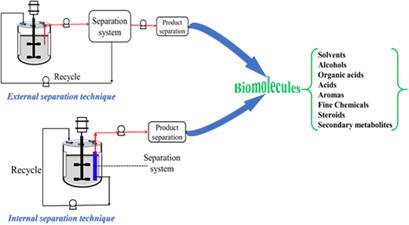当前位置:
X-MOL 学术
›
ChemBioEng Rev.
›
论文详情
Our official English website, www.x-mol.net, welcomes your
feedback! (Note: you will need to create a separate account there.)
Extractive Fermentation Processes: Modes of Operation and Application
ChemBioEng Reviews ( IF 6.2 ) Pub Date : 2021-12-29 , DOI: 10.1002/cben.202100028 George M. Teke 1 , Siew L. Tai 2 , Robert W. M. Pott 1
ChemBioEng Reviews ( IF 6.2 ) Pub Date : 2021-12-29 , DOI: 10.1002/cben.202100028 George M. Teke 1 , Siew L. Tai 2 , Robert W. M. Pott 1
Affiliation

|
Bioprocesses can be hampered by product concentrations within a fermentation leading to product-inhibition, and reductions in yield and productivity. This limitation impacts operational considerations, process economics, and viability, and, ultimately, whether a technology is industrially viable. One approach to circumventing these concerns is in situ extraction of products. In this way, the organism is no longer exposed to the inhibitory product, and fermentation can proceed, often at improved rates. Significant advances in this field have been made in recent years, however, they are for the most part siloed into sub-fields (focusing on the product extracted, or the method of extraction). This review considers in situ extraction more holistically in terms of i) the separation methodology, ii) the mode of reactor operation, and iii) the physical reactor configuration. The summary hopes to give insight into promising areas for research and potentially spark ideas for novel in situ extractive processes.
中文翻译:

萃取发酵过程:操作和应用模式
发酵过程中的产物浓度可能会阻碍生物过程,从而导致产物抑制,以及产量和生产力的降低。这种限制会影响操作考虑、过程经济性和可行性,并最终影响技术在工业上是否可行。避免这些问题的一种方法是原位提取产品。通过这种方式,有机体不再暴露于抑制产物,并且发酵可以继续进行,通常以更高的速率进行。近年来,该领域取得了重大进展,但是,它们大部分都被划分为子领域(侧重于提取的产品或提取方法)。本综述从 i) 分离方法、ii) 反应器运行模式、iii) 物理反应堆配置。该摘要希望能够深入了解有前景的研究领域,并可能激发新的原位提取工艺的想法。
更新日期:2021-12-29
中文翻译:

萃取发酵过程:操作和应用模式
发酵过程中的产物浓度可能会阻碍生物过程,从而导致产物抑制,以及产量和生产力的降低。这种限制会影响操作考虑、过程经济性和可行性,并最终影响技术在工业上是否可行。避免这些问题的一种方法是原位提取产品。通过这种方式,有机体不再暴露于抑制产物,并且发酵可以继续进行,通常以更高的速率进行。近年来,该领域取得了重大进展,但是,它们大部分都被划分为子领域(侧重于提取的产品或提取方法)。本综述从 i) 分离方法、ii) 反应器运行模式、iii) 物理反应堆配置。该摘要希望能够深入了解有前景的研究领域,并可能激发新的原位提取工艺的想法。











































 京公网安备 11010802027423号
京公网安备 11010802027423号